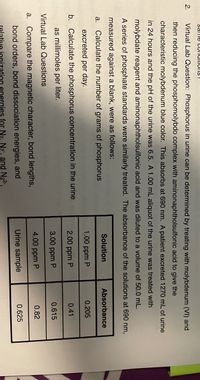
Chemistry
10th Edition
ISBN: 9781305957404
Author: Steven S. Zumdahl, Susan A. Zumdahl, Donald J. DeCoste
Publisher: Cengage Learning
expand_more
expand_more
format_list_bulleted
Concept explainers
Question
2a please

Transcribed Image Text:Same CUInUitiulIS !
2.
Virtual Lab Question: Phosphorus in urine can be determined by treating with molybdenum (VI) and
then reducing the phosphomolybdo complex with aminonaphtholsulfonic acid to give the
characteristic molybdenum blue color. This absorbs at 690 nm. A patient excreted 1270 mL of urine
in 24 hours and the pH of the urine was 6.5. A 1.00 mL aliquot of the urine was treated with
molybdate reagent and aminonaphtholsulfonic acid and was diluted to a volume of 50.0 mL.
A series of phosphate standards were similarly treated. The absorbance of the solutions at 690 nm,
measured against a blank, were as follows:
Solution
Absorbance
а.
Calculate the number of grams of phosphorus
excreted per day.
1.00 ppm P
0.205
b. Calculate the phosphorus concentration in the urine
2.00 ppm P
0.41
as millimoles per liter.
3.00 ppm P
0.615
Virtual Lab Questions
4.00 ppm P
0.82
a. Compare the magnetic character, bond lengths,
bond orders, bond dissociation energies, and
Urine sample
0.625
nization energies for N2. N2", and N22-,
Expert Solution
This question has been solved!
Explore an expertly crafted, step-by-step solution for a thorough understanding of key concepts.
Step by stepSolved in 2 steps with 1 images

Knowledge Booster
Learn more about
Need a deep-dive on the concept behind this application? Look no further. Learn more about this topic, chemistry and related others by exploring similar questions and additional content below.Similar questions
- RQ IFC CI OEt AICI 3 14arrow_forwardJust #2 pleasearrow_forwardBelow are 3 real life situations. Pick two (2) them and explain ALL the science involved in the scenario. This means describe things like what is happening to the gas/liquid/solid molecules or atoms, which principles or laws are at work, why what is happening is happening, and how you know. At sea level, a pot of water will boil at 100 °C. Suppose you wanted to boil the same amount of water high in the Rocky Mountains. What do you expect the temperature will need to be (generally speaking)? Why? A can of soda sits in a sunny spot on the window sill for several hours. It is then opened at the same time as a cold can of soda from the refrigerator. What happens and why? Weather balloons do not float out into space. They reach an altitude of about 15 miles above the surface (3x the height of Mt Everest) and they burst. Why?arrow_forward
- When the temperature is lowered, the speed at which molecules move is slowed. O False stly cloudy True O Searcharrow_forwardThe particles in a gas vibrate faster than the particles in a liquid. F ostly cloudy O True F6 Search F7 F8 F9 O False F10 LA 81 8arrow_forwardbrian wants to hit the beach and go diving. However if his body doesn't take up enough space he could sink and drown. He tries to measure himself with a "ruler" but the life guard sais that's not good enough.arrow_forward
- Use the de Broglie relationship to determine the wavelengths of the following objects.arrow_forwardTemperature differences on the Rankine scale are identical to differences on the Fahrenheit scale, but absolute zero is given as 0°R. (a) Find a relationship converting the temperatures TF of the Fahrenheit scale to the corresponding temperatures TR of the Rankine scale. TR = (b) Find a second relationship converting temperatures TR of the Rankine scale to the temperatures TK of the Kelvin scale. TK =arrow_forwardConvert 76.9 L to cm3. O76900 cm3 O 7690 cm3 O 769000000 cm³ O769000 cm3arrow_forward
arrow_back_ios
arrow_forward_ios
Recommended textbooks for you
 ChemistryChemistryISBN:9781305957404Author:Steven S. Zumdahl, Susan A. Zumdahl, Donald J. DeCostePublisher:Cengage Learning
ChemistryChemistryISBN:9781305957404Author:Steven S. Zumdahl, Susan A. Zumdahl, Donald J. DeCostePublisher:Cengage Learning ChemistryChemistryISBN:9781259911156Author:Raymond Chang Dr., Jason Overby ProfessorPublisher:McGraw-Hill Education
ChemistryChemistryISBN:9781259911156Author:Raymond Chang Dr., Jason Overby ProfessorPublisher:McGraw-Hill Education Principles of Instrumental AnalysisChemistryISBN:9781305577213Author:Douglas A. Skoog, F. James Holler, Stanley R. CrouchPublisher:Cengage Learning
Principles of Instrumental AnalysisChemistryISBN:9781305577213Author:Douglas A. Skoog, F. James Holler, Stanley R. CrouchPublisher:Cengage Learning Organic ChemistryChemistryISBN:9780078021558Author:Janice Gorzynski Smith Dr.Publisher:McGraw-Hill Education
Organic ChemistryChemistryISBN:9780078021558Author:Janice Gorzynski Smith Dr.Publisher:McGraw-Hill Education Chemistry: Principles and ReactionsChemistryISBN:9781305079373Author:William L. Masterton, Cecile N. HurleyPublisher:Cengage Learning
Chemistry: Principles and ReactionsChemistryISBN:9781305079373Author:William L. Masterton, Cecile N. HurleyPublisher:Cengage Learning Elementary Principles of Chemical Processes, Bind...ChemistryISBN:9781118431221Author:Richard M. Felder, Ronald W. Rousseau, Lisa G. BullardPublisher:WILEY
Elementary Principles of Chemical Processes, Bind...ChemistryISBN:9781118431221Author:Richard M. Felder, Ronald W. Rousseau, Lisa G. BullardPublisher:WILEY

Chemistry
Chemistry
ISBN:9781305957404
Author:Steven S. Zumdahl, Susan A. Zumdahl, Donald J. DeCoste
Publisher:Cengage Learning

Chemistry
Chemistry
ISBN:9781259911156
Author:Raymond Chang Dr., Jason Overby Professor
Publisher:McGraw-Hill Education

Principles of Instrumental Analysis
Chemistry
ISBN:9781305577213
Author:Douglas A. Skoog, F. James Holler, Stanley R. Crouch
Publisher:Cengage Learning

Organic Chemistry
Chemistry
ISBN:9780078021558
Author:Janice Gorzynski Smith Dr.
Publisher:McGraw-Hill Education

Chemistry: Principles and Reactions
Chemistry
ISBN:9781305079373
Author:William L. Masterton, Cecile N. Hurley
Publisher:Cengage Learning

Elementary Principles of Chemical Processes, Bind...
Chemistry
ISBN:9781118431221
Author:Richard M. Felder, Ronald W. Rousseau, Lisa G. Bullard
Publisher:WILEY